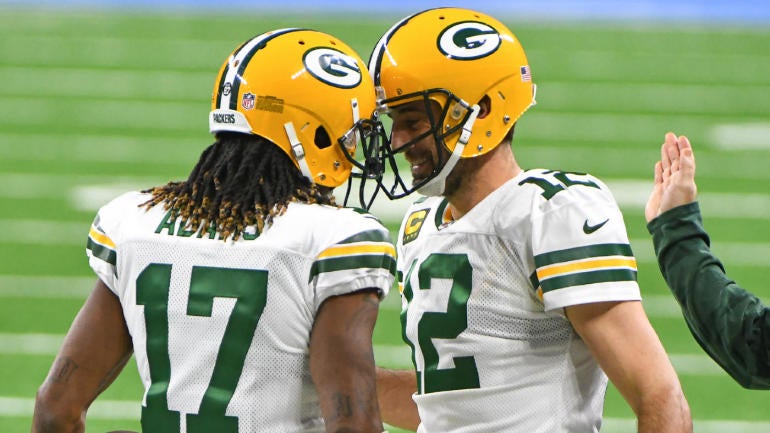
A few weeks back, we used this space to dig into what the Green Bay Packers have done differently on defense this year to help themselves stay afloat despite the absence of their two best defensive players. With the Packers on the verge of improving to 13-3 for the third consecutive season, we're now going to dive into one of the most important aspects of the team's offense.
At first glance, Green Bay's offense doesn't seem all that special. The Packers rank 15th in the NFL in yards and 13th in the league in points. Go a bit more granular and you see some improvement: the Packers are 12th in yards per play and eighth in points per drive. They also rank eighth in the share of their drives that end in a touchdown or field goal. None of those figures is necessarily the sign of an elite offense. And yet, the Packers rank second in the league in offensive efficiency, as measured by Football Outsiders' DVOA.
So, what gives?
To me, it all comes down to the Packers' ability to do the one thing that has given so many other top offenses trouble at different times throughout this season: move the ball down the field slowly, with short gains, without getting impatient and making a mistake. The Packers have averaged 6.4 plays and 35.4 yards per drive thus far this season, the second- and fourth-best figures in the NFL. They also hold the ball for an average of 3 minutes, 14 seconds on any given possession, the highest mark in the league. Maintaining that degree of possession is incredibly difficult, but Green Bay has gotten there by turning the ball over on only 5.2% of its drives, the single-best mark in the NFL.
The Packers' ability to move the ball downfield in small chunks is more impressive when you consider the relative ineffectiveness of their running game compared to years past. Aaron Jones had averaged 5.2 yards per carry prior to this season. A.J. Dillon averaged 5.3 per carry as a rookie. They are at 4.4 (Jones) and 4.3 (Dillon) per carry this season, likely owing to the season-long offensive line carousel the Packers have been on. David Bakhtiari has yet to play this year. Elgton Jenkins played in only eight games. Josh Myers lasted just five. It's perhaps not surprising, then, that both backs have yards before contact per carry averages below the league average, according to TruMedia.
Rather than with the run, the Packers matriculate the ball downfield via the short pass. No team in the NFL is better in the quick game, largely because no quarterback in the NFL is better than Aaron Rodgers in the quick game. On throws within 2.5 seconds of the snap, according to Pro Football Focus, Rodgers is 208 of 277 for 1,811 yards, and 22 touchdowns, and he has yet to throw an interception. Those figures yield a 119.9 passer rating, an obviously elite mark. And he's accumulated those numbers while releasing the ball in, on average, 1.75 seconds -- tied for the fastest trigger in the league on quick-strike throws.
Rodgers is better than anybody at working the area close to the line of scrimmage, both because he has one of the best close-to-the-line weapons in the league in Davante Adams and because the design of the Packers' offense builds in more "layup" throws than any other offense in the NFL. There's a reason that Rodgers ranks first in the league in EPA per dropback on non-red-zone throws of 0 to 10 air yards, and that the distance between Rodgers in first (0.27 EPA per play) and Ryan Tannehill in second (0.19) is equivalent to the distance between Tannehill and 11th-place Matthew Stafford (0.11). The design, working in concert with Rodgers' decision-making and lightning-quick release, all congeal together to create easy, low-risk gains.
The Packers have a diverse and varied screen game, but my favorite variation is what I call the flat screen. (It probably has another name but I like it because it describes exactly what the play is.)
These are throws that stand almost no chance of being intercepted or even affected by any defensive lineman. They get the ball into the hands of a playmaker with a ton of space in front of him, and also with plenty of blocking. Because Rodgers releases the ball so quickly, there's little chance of an offensive pass interference penalty being called on one of the receivers for blocking before the pass arrives. Maybe they only gain 4 or 5 yards, but they loosen up the defense, keep the chains moving, and give players a chance to create a big play on the perimeter.
The Packers might also utilize more pick routes than any team in the NFL. The target of these plays is typically Adams, though they will also on occasion have Adams run off a defender and sneak a tight end or one of the backs into the flat to give Rodgers an easy pitch and catch for some free yards.
More than anything, though, it's Rodgers' chemistry with Adams -- and the pair's respective elite talents -- that makes the quick-game passing attack truly sing. They are both just so precise in everything they do. They put on a weekly clinic in footwork, body control, ball placement, and a whole lot more. It's special to watch. The attention that must be paid to Adams (he almost always has safety help over the top of his route or his side of the field) opens up the easiest of throws to the other receivers, and Rodgers can just take the free yards and keep the offense moving.
I'm not entirely sure how defenses are supposed to stop these types of throws. I'm not sure they even want to. Most defenses are concentrated on taking away the deep ball these days. The Packers hit plenty of those downfield shots, and with more precision than plenty of other offenses. But it's their proficiency at the types of throws defenses want to force that makes them so tough to stop this year.






















